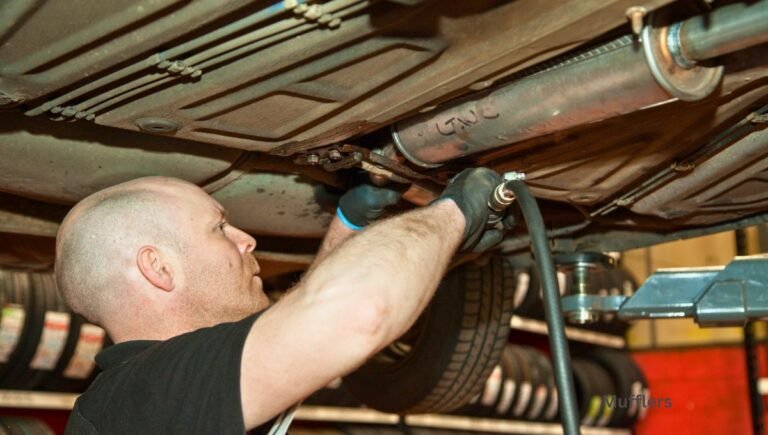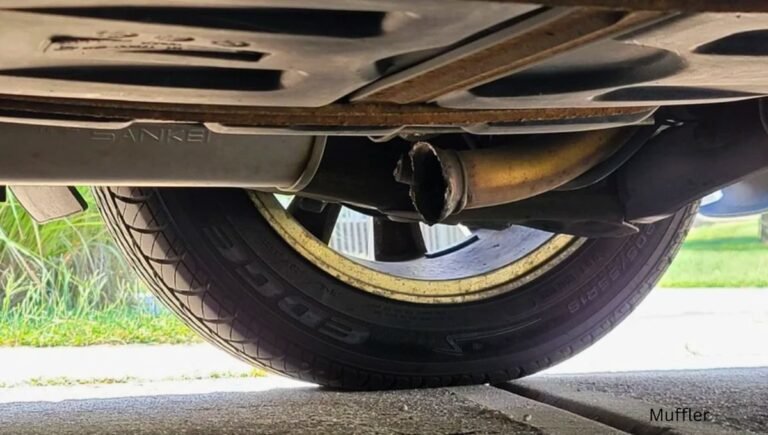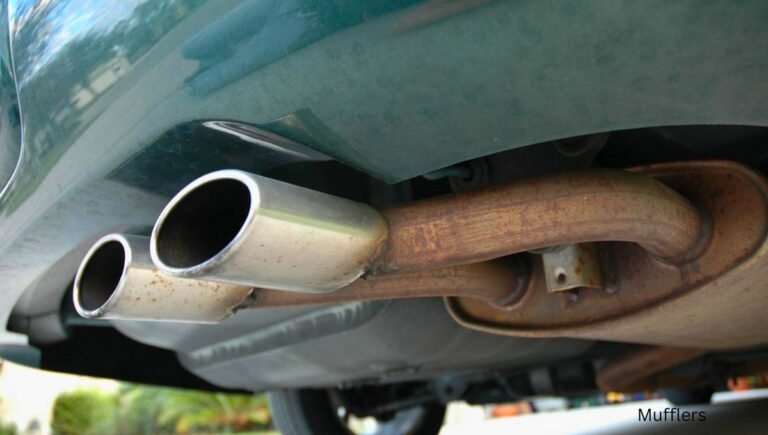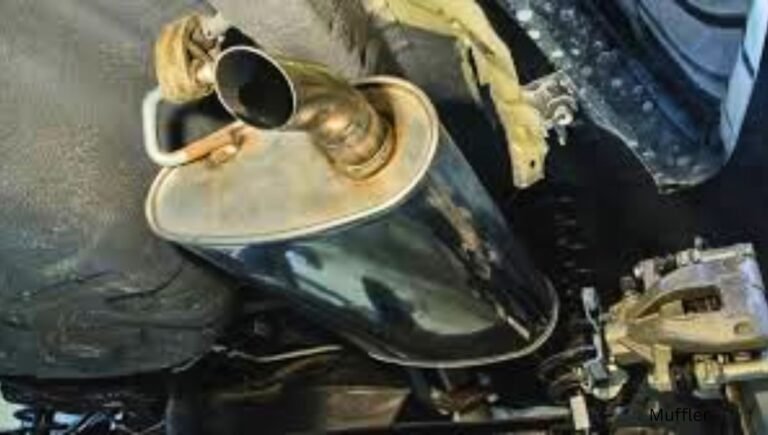How Long Does It Take to Replace a Muffler: Quick Guide
Replacing a muffler typically takes around 1-2 hours depending on the vehicle and complexity. The process involves removing the old muffler and installing the new one, which can be done relatively quickly by a trained mechanic.
Factors such as the type of vehicle, accessibility of the muffler, and any additional repairs needed can impact the total time required for the replacement. It is advisable to consult with a professional mechanic to get an accurate estimate for your specific vehicle.
Proper installation of a new muffler is essential for optimal vehicle performance and noise reduction.
Introduction To Muffler Replacement
Replacing a muffler is a quick and efficient process, typically taking around 1-2 hours. A skilled technician can remove the old muffler, install the new one, and ensure a proper fit, allowing you to enjoy a quiet and smooth ride in no time.
The muffler is a crucial component of your vehicle’s exhaust system, responsible for reducing noise and harmful emissions. Over time, mufflers can become damaged or worn out, causing a variety of issues. If you’re experiencing problems with your muffler, it’s important to address them promptly to prevent further damage to your car and ensure your safety on the road.Significance Of A Muffler
A muffler serves an important purpose in reducing the noise emitted by your vehicle’s exhaust system. This is accomplished through the use of chambers and baffles that reduce the pressure and speed of the exhaust gases, resulting in a quieter ride. Additionally, mufflers help to filter out harmful pollutants and emissions, making them an essential part of any vehicle’s emissions control system.Symptoms Of A Failing Muffler
If your muffler is failing, you may notice a variety of symptoms that indicate it’s time for a replacement. One of the most common signs of a damaged muffler is increased noise from your vehicle’s exhaust system. You may also notice a decrease in fuel efficiency, as a damaged muffler can cause your engine to work harder than it should. Other symptoms of a failing muffler include a decrease in engine performance, a strong smell of exhaust fumes, and visible damage or corrosion to the muffler itself. If you’re experiencing any of these symptoms, it’s important to have your muffler checked by a qualified mechanic. They can help you determine if a replacement is necessary and provide you with the necessary repairs to keep your vehicle running smoothly.Assessing The Condition
Replacing a muffler can typically be done within a few hours, depending on the specific vehicle and the skill level of the mechanic. It is important to assess the condition of the muffler before determining the exact time required for replacement.
Before replacing a muffler, it is important to assess its condition. This will help in determining whether a replacement is necessary and how long it will take to complete the task. Assessing the condition of a muffler involves visual inspection and performance checks.Visual Inspection
Visual inspection involves examining the muffler for signs of wear and tear, such as rust, cracks, or holes. This can be done using a flashlight to inspect the muffler from different angles. If the muffler shows any of these signs, it is recommended to replace it as soon as possible.Performance Checks
Performance checks involve testing the muffler’s noise reduction capabilities and checking for any leaks. This can be done by starting the engine and listening for any unusual noises or vibrations. Leaks can be detected by inspecting the exhaust system for any black soot or residue. If the muffler fails any of these performance checks, it is recommended to replace it immediately. The time it takes to replace a muffler will depend on the condition of the old muffler and the type of replacement muffler being installed. In conclusion, assessing the condition of a muffler is crucial in determining whether it needs to be replaced and how long the replacement will take. It is recommended to have a professional mechanic inspect and replace the muffler for optimal performance and safety.Factors Influencing Replacement Time
Vehicle Model Variations
Vehicle model variations can significantly impact the time it takes to replace a muffler. Newer models may have more complex exhaust systems, requiring additional time for disassembly and reassembly. On the other hand, older vehicles with rusted or corroded components may pose challenges during the removal process, potentially extending the replacement duration.
Muffler Types And Compatibility
The type and compatibility of the muffler also play a crucial role in determining the replacement time. Performance mufflers, such as those designed for enhanced exhaust flow and sound, may involve intricate installation procedures, leading to a longer replacement timeframe. Additionally, ensuring the compatibility of the new muffler with the vehicle’s exhaust system is essential to prevent fitting issues and delays.
Tools And Materials Needed
Replacing a muffler is a relatively simple task that can be done at home with the right tools and materials. By having everything you need on hand, you can save time and ensure a smooth and efficient installation process. In this section, we will outline the essential tools and additional supplies required for replacing a muffler.
List Of Essential Tools
To replace a muffler, you will need the following tools:
- Socket wrench set
- Jack stands
- Hydraulic jack
- Penetrating oil
- Wire brush
- Safety goggles
- Gloves
These tools are essential for safely and effectively removing the old muffler and installing the new one.
Additional Supplies
In addition to the tools mentioned above, you may also need the following supplies:
- New muffler
- New exhaust clamps
- Gasket
- Exhaust sealant
- Anti-seize compound
These supplies are necessary for ensuring a proper and secure fit of the new muffler, preventing any leaks or vibrations.
Before starting the replacement process, make sure you have all the tools and supplies listed above. This will help you complete the task efficiently and without any unnecessary delays. Now that we have covered the tools and materials needed, let’s move on to the step-by-step process of replacing a muffler in our next section.
Preparation Steps
Before you start replacing a muffler, it is important to follow certain preparation steps to ensure a smooth and safe process. These steps include taking necessary safety precautions and setting up your vehicle properly.
Safety Precautions
When working on your vehicle, safety should always be a top priority. Here are some essential safety precautions to consider:
- Ensure you are working in a well-ventilated area to avoid inhaling harmful fumes.
- Wear protective gloves and safety goggles to protect your hands and eyes from any potential hazards.
- Make sure the vehicle is parked on a flat and stable surface to prevent accidents.
- Apply the parking brake and block the wheels to prevent the vehicle from rolling.
- Allow the exhaust system to cool down completely before attempting any work.
Vehicle Setup
Properly setting up your vehicle will make the muffler replacement process easier and more efficient. Here’s what you need to do:
- Gather all the necessary tools and equipment for the job, such as jack stands, a socket wrench, and a new muffler.
- Locate the muffler on your vehicle. Refer to the owner’s manual if you are unsure.
- Position the jack stands securely under the vehicle to provide support and stability.
- Use the jack to raise the vehicle to a suitable height, allowing easy access to the muffler.
- Double-check that the vehicle is securely supported by the jack stands before proceeding.
By following these preparation steps, you can ensure a safer and more efficient muffler replacement process. Remember to prioritize safety and take your time to complete each step carefully.
The Replacement Process
Removal Of The Old Muffler
First, the vehicle is securely raised on a lift or jack stands to provide access to the muffler. The technician then sprays penetrating oil on the muffler hangers and bolts to ease their removal. Using appropriate tools, they carefully detach the exhaust system from the hangers and loosen the clamps or bolts connecting the muffler to the exhaust pipes.
Installation Of The New Muffler
After removing the old muffler, the technician inspects the exhaust pipes and hangers for any damage or corrosion. If necessary, they will clean or replace any components. Then, the new muffler is positioned and secured in place using new clamps or bolts. Finally, the exhaust system is reconnected, and the vehicle is lowered to the ground for a test run.
Time-saving Tips
When it comes to replacing a muffler, time-saving tips can be a game-changer. By following expert advice and avoiding common mistakes, you can streamline the process and get back on the road faster.
Expert Advice
Consult with a mechanic for accurate time estimates.
- Prepare all necessary tools in advance.
- Work in a well-lit and organized workspace.
- Follow a step-by-step guide or tutorial.
Avoiding Common Mistakes
Improper installation can lead to delays.
- Avoid overtightening bolts.
- Ensure proper alignment of the muffler.
- Double-check all connections before testing.
Post-replacement Checks
After replacing a muffler, it’s important to conduct post-replacement checks to ensure everything is in working order. The time it takes to replace a muffler can vary depending on the complexity of the job and the availability of parts. However, a professional mechanic can usually complete the task in a few hours.
Ensuring Proper Installation
After replacing the muffler, ensure it is securely attached. Check for any signs of leaks or loose connections.Performance Testing
Test the vehicle to ensure the muffler functions properly. Listen for any unusual noises or vibrations. Post-Replacement Checks: After replacing a muffler, it is crucial to conduct thorough post-replacement checks to ensure everything is in proper working order. Here are some essential steps to follow:Ensuring Proper Installation
– Securely attach the new muffler in place. – Check for leaks or loose connections.Performance Testing
– Test the vehicle to ensure proper function. – Listen for any unusual noises or vibrations.Professional Service Vs. Diy
Replacing a muffler can take anywhere from 30 minutes to 2 hours. While a professional service will ensure the job is done quickly and efficiently, a DIY approach may save money but may take longer and require more effort.
Cost Considerations
Professional service often costs more upfront than DIY.
DIY saves money but requires time and skill.
Consider budget and expertise before deciding.
Time Considerations
Professional service is quicker and more efficient.
DIY takes longer but offers a sense of accomplishment.
Time availability plays a key role in the decision.
Maintenance To Prolong Muffler Life
Maintaining your muffler is crucial to ensure its longevity and efficiency. By following proper maintenance practices, you can significantly prolong the life of your muffler, saving you time and money in the long run.
Routine Inspection
Regularly inspect your muffler for signs of wear and damage. Look out for rust, holes, or loose connections that may indicate the need for repair or replacement.
Preventive Measures
Take preventive measures such as cleaning the muffler regularly to remove dirt and debris that can cause corrosion. Avoid driving over rough terrain or through deep water to prevent damage to the muffler.
Legal And Environmental Considerations
Noise Regulations
In many regions, there are strict noise regulations in place to control the amount of sound emitted from vehicle exhaust systems. When replacing a muffler, it is crucial to ensure that the new one complies with these regulations to avoid potential fines or penalties.
Emissions Standards
Emissions standards dictate the maximum level of pollutants that a vehicle can release into the environment. When replacing a muffler, it is essential to choose a model that meets or exceeds these standards to minimize the environmental impact of the vehicle.
Conclusion
Replacing a muffler typically takes 1-2 hours. The process involves removing the old muffler and installing the new one, making sure it fits properly. It’s important to consider the type of vehicle and the expertise of the mechanic. By understanding the process, you can make informed decisions about your car maintenance.






